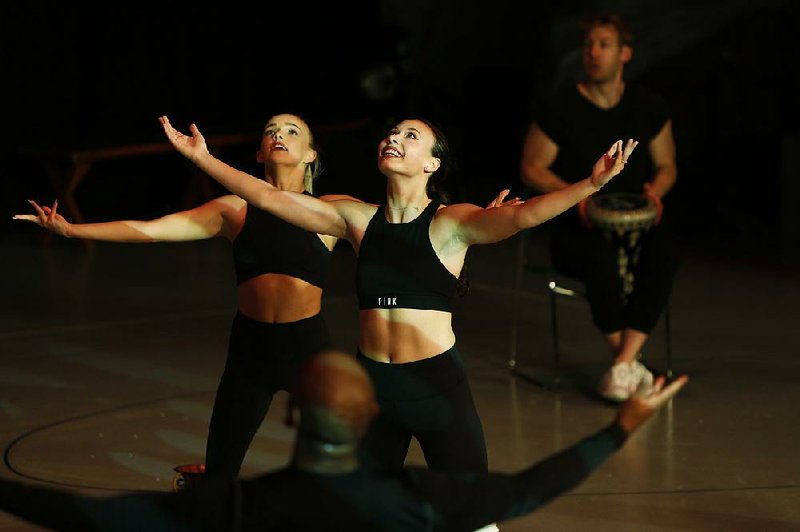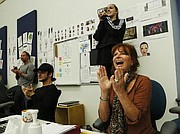MIAMI -- In a nondescript building in north Miami, two dozen dancers in bouncing yellow skirts are high kicking the can-can, aerialists are spinning perilously high from silk cords and frantic seamstresses are hemming outfits in a 20,000-square-foot costume shop. They are all part of a company that puts on more live productions a year than Broadway and London's West End combined.
Royal Caribbean International's cruise line directs 134 shows in 50 theaters on 26 ships around the world, including seven Broadway-originating shows, eight aqua shows, 18 ice shows and dozens of original musicals.
"We have a nightly audience of about 100,000. It is by scale a very, very large operation. Probably under one roof, the biggest in the world," said Nick Weir, senior vice president of entertainment. "At any one time, there's 1,500 to 1,800 cast members employed to make this all come to life."
It takes two to four weeks for an army of dancers, singers and aerialists to learn a show before they're dispatched to ports as far away as Australia and China.
On a recent afternoon, dancers roamed the halls in crop tops and buns. One stretched into a wide split on the floor. There are 14 dance studios, 15 rehearsal rooms, a recording studio, gymnasiums and auditorium. Exercise equipment lines some hallways. Nearby are living accommodations for 470 of the performers.
Often dismissed in the past as second-tier, cruise entertainment has evolved to a genre that Royal Caribbean said commands some of the best talent and technology around.
Several of the main characters in Mama Mia are from the Broadway version of the show. While New York theater has struggled to turn profits with its small, intimate venues, fickle crowds and finite real estate, the cruise industry's onboard audience is growing exponentially.
Royal Caribbean is building five ships in the coming years, each with a custom-built theater with sophisticated stages and high-tech effects. A few years ago, they built a small plane with a 22-foot wingspan that now flies over the audience in every production of FLIGHT: Dare to Dream.
"The stages that they have on the ships, the technology is far better than it ever was on a Broadway stage, even 10 years ago," said Greg Graham, who was the resident choreographer for Billy Elliot on Broadway before joining the cruise line to choreograph Hairspray.
Roughly 3,000 hopefuls showed up to recent auditions for Hairspray in New York and London.
Weir said the casting operation is huge, culling talent from 75 cities a year, and auditioning nearly 25,000 performers last year.
"At my audition there were hundreds of girls ... it's very competitive. There are so many people who want to be doing this," said Taryn Borman, a 21-year-old Australian dancer who's performing on a ship for the first time in a new show with aerialists and contortionists. She'll head to Asia with the cast in a few weeks.
Singer and dancer Oli Reynolds, 26, wrapped up a starring role in London's West End production of Mama Mia and went back to Royal Caribbean where he's reprising the same role.
"I think there's still a stigma about cruise ship performing ... historically, a lot of cruise lines didn't put the focus on the performing, it was more about the destinations," said Reynolds, who stressed that's changed. "People come from Cirque du Soleil, they come from Vegas, they come from London, they come from Broadway and it is a progression in my career for me."
John Kenrick, a musical theater historian and adjunct professor at New York University, said the evolution was inevitable as more sophisticated cruise audiences -- accustomed to seeing shows in spots like Las Vegas and Atlantic City, N.J. -- are demanding better entertainment.
"It's certainly upped the game. [Cruise theater] used to be a little better perhaps than summer stock just with better costumes," said Kenrick, adding "it's definitely improved. I can't say it's Broadway."
The cast on each ship performs three shows -- a Broadway musical like Hairspray or Grease, a ballroom-style show and a pop show. The shows are upbeat and family oriented and chosen to appeal to a wide audience -- nothing too sexual or intellectual.
Scheduling all the rehearsals is more precise than the choreography. The new casts arrive, rehearse and depart to sea every few weeks. It takes exactly 26 days to train a new cast to perform the musical Cats.
Typical theater productions will rotate in new cast members periodically, but Royal Caribbean prefers to sign performers to roughly nine-month contracts. They spend a few weeks learning three shows from scratch and then head to sea. When it's over, the cruise line casts a new set of performers and begins again.
Staging a show at sea has its own challenges and quirks. Performers need extra core strength to adapt to rough waves and pitching ships. If a costume is ripped, there's no one to run to the store.
There are also perks that even the most legendary theaters on land can't compete with -- picturesque ports, free meals, room and board, the chance to interact with the audience and the sense of onboard community not found at other venues where performers simply go home each night.
"You definitely become more of a family," said Mya Carpenter, a 22-year-old dancer who performed in Paris before joining Royal Caribbean. "You come to know people inside and out. They're friends for life."
SundayMonday Business on 05/05/2019

